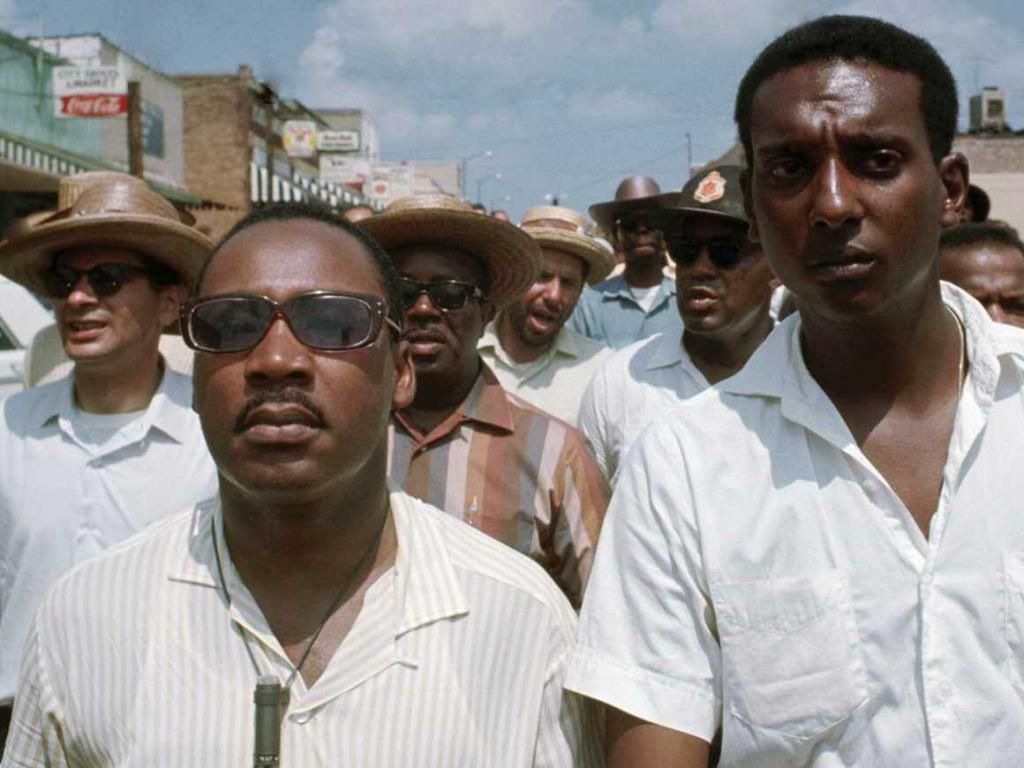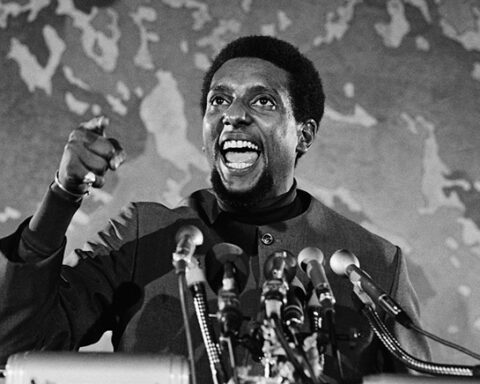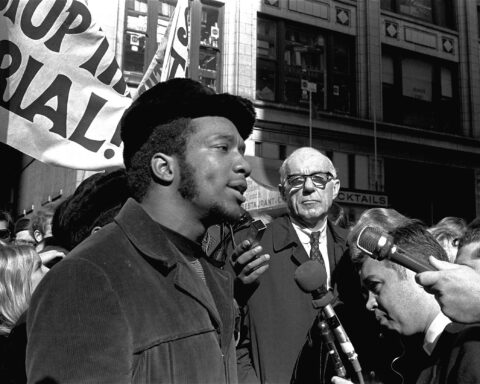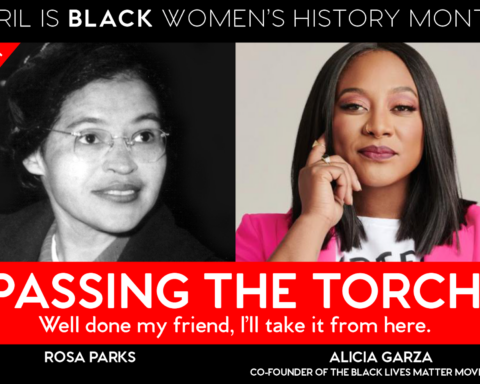By Terry Gross
Journalist Mark Whitaker says that much of what’s happening in American race relations today traces back to 1966, the year when the Black Panthers were founded and the Black Power movement took full form. It’s also the year when when Stokely Carmichael replaced John Lewis as chair of the Student Nonviolent Coordinating Committee (SNCC), and challenged the tactic of non-violence.
Whitaker examines the pivotal year in his new book, Saying It Loud: 1966 — The Year Black Power Challenged the Civil Rights Movement. Whitaker notes that for years the rallying cry of the civil rights movement had been “Freedom now!” But, he says, on June 16, 1966, Carmichael ushered in a new call to arms — “Black Power!” — during a rally in Greenwood, Miss.
“The next day [the chant] gets reported by the Associated Press,” Whitaker says. “The story gets picked up in 200 newspapers around the country, and all of a sudden, everybody’s talking about Black Power.”
Whitaker writes that it wasn’t just the language of the civil rights movement that changed in 1966. There was also an “awakening of Black consciousness on a cultural level,” he says. “It was really the year when Afros took off, when people started wearing dashikis, where a lot of young Blacks said, ‘We don’t want to be called Negroes anymore.'”
There was also a notable shift away from integration, Whitaker says. Carmichael advocated for Black people to create their own political party and to elect their own officials. As the leader of the SNCC, he expelled the group’s white members, leading to a drop in the group’s fundraising and political clout. All of this, Whitaker says, laid the foundation for the modern conservative movement — including the election of Ronald Reagan as governor of California in 1966 and George Wallace‘s presidential run in 1968.
“A big lesson of 1966 is, beware of the potential backlash,” Whitaker says. “I was writing this book in 2020 in the midst of all the marches that summer. … I see what happened in 1966 and what happened in 1966 tells me that there is going to be hell to pay. There’s going to be a big backlash to what looks like all this progress in 2020. And sure enough, that’s what we’re living with right now.”
Whitaker is the first African American to lead a national news magazine as editor of Newsweek. His previous books include Smoketown, My Long Trip Home and the 2014 biography Cosby, which was later widely criticized for not addressing multiple allegations that superstar comic Bill Cosby had drugged and sexually assaulted women. Whitaker has since acknowledged that it was a mistake to omit the allegations from his book, tweeting, “I was wrong to not deal with the sexual assault charges against Cosby and pursue them more aggressively.”
On Stokely Carmichael’s approach to the civil rights movement
What Stokely realized, particularly after the passage of the Voting Rights Act in 1965, was that just registering Blacks in the South to vote really wasn’t going to get them that far, as difficult as that was. Why? Because those states were completely controlled by segregationist Democrats, the most famous of which we all know was George Wallace, who was the governor of Alabama. So, Stokely’s position was, why should we register all of these Black folks to vote just to have to turn around and vote for white supremacists? So what he wanted to do was to organize, and what he started in Lowndes County, Alabama, in ’65 and ’66, was organizing Blacks to form their own political party. They could elect their own officials. …
In terms of integration, what Stokely was saying about the South (vis à vis poor Blacks) and then later the Panthers were saying, even in the North (vis à vis urban Blacks in places like Oakland) … was that actually white people were not interested in integrating with poor Blacks in the South or in the North. That integration was sort of a project by middle-class Blacks for middle-class white people who might be willing to live side by side with their kind, with the Black middle class, but not necessarily with the Black poor and the Black underclass in the North.
On the tension within the civil rights movement caused by the different approaches its leaders took
The press portrayed Carmichael as [Martin Luther] King’s nemesis. But in fact, on a personal level, they got along quite well. Stokely had a lot of respect for Dr. King. Dr. King didn’t agree necessarily with all of Stokely’s rhetoric, but he admired the fact that he was an activist who had put his life on the line and going out to organize in the South. But there were both sort of differences that had to do with tactics and strategy, but also with background. So one of the things that was different about the Black Power leaders was some of them had come out of the South, but a lot of them came out of the North. So they were the children of the Great Migration. Their parents and grandparents had come north from the South. They had had educational opportunities that Blacks in the South didn’t necessarily have. Carmichael himself had gone to Howard University and before that to the Bronx High School of Science in New York, an elite high school. And they just didn’t have the sort of tradition of deference, frankly, that the older generation in the South had. They were less rooted in the church than the previous civil rights generation. So they just sort of had a different attitude. They were impatient. They had seen their parents’ dreams dashed when they came north in the Great Migration.

A newly registered voter fills out a sample ballot for sheriff in Lowndes County. The ballot has the logo of the Black Panther Party formed by Stokely Carmichael of SNCC.
Flip Schulke Archives/Corbis via Getty Images/Simon & Schuster
On John Lewis’ ouster from from SNCC in 1966
After Selma, he was famous and he used that fame to go around the country and also overseas to raise money for SNCC. So that was good for SNCC’s coffers, but it actually distanced him from a lot of the SNCC membership. And so he got out of touch with this increasingly militant mood that was taking shape in 1966. And that spring there was one of these periodic retreats that SNCC would have the entire membership … discuss strategy, but they would also elect officers for the next year. And Lewis had been in Europe, giving speeches, raising money. He arrives badly jetlagged to this retreat at a religious camp outside of Nashville, expecting that he’s going to be reelected. But a lot of the rank and file SNCC members at that point were upset with him for being too distant, too preoccupied with all of this travel, but also with still being too close to King, but actually, I think the issue was much more with LBJ. .. And this time Stokely wins. It crushed John Lewis. … This had been his identity. He grew up as a poor sharecropper for his young life. … We remember him now as the sainted congressman and beloved national figure. But that experience just completely crushed him. And it took a long time for him to recover.
On what Carmichael’s leadership meant for SNCC
I think it had two effects: One was on the way that SNCC was perceived by the outside world, particularly the white world. John Lewis was someone who was deeply respected by white journalists by people who gave money to SNCC. And once they learned that he had been removed, very precipitously, unexpectedly, it immediately sort of cast a shadow over the people who had ousted him. In other words, Stokely Carmichael and the new leadership group. They were immediately suspect in the eyes of a lot of people who supported John Lewis.
But the other effect was internal. John Lewis had always stood for the principle of SNCC being open to white membership. He had a lot of very close friends among some of the original white members of SNCC. And so that to the degree that, as 1966 progressed and the whole issue of white participation loomed larger and larger, and it eventually led by the end of the year to the expulsion of the last remaining white members of SNCC, I think if John Lewis had been there, he would have fought that very aggressively. And once he was gone, the door was more and more open to that happening.
On the origins of the Black Panthers’ militarism
In Watts, after the the Watts riots of 1965 in Los Angeles, there had been a group of local Black activists who had decided that they were going to ride around just looking out for situations where police, white police were interacting with the local Black population and just stand at a remove where the police could see them, but where they weren’t trying to interfere, but just to make their presence known. Like, “We’re watching this. So if anything gets out of hand, if the police in any way abuse their authority, we will be witnesses.”
And up in the Bay Area, in Oakland, Huey Newton and Bobby Seale, who were in a community college there at that point, they’re following all of this and Huey Newton … becomes aware that in California at the time, there were open carry gun laws. In other words, it was perfectly legal to carry arms in public as long as you could see them. And so his idea was that he was going to take what was going on in Watts a step further and form a community patrol, but with guns, so that he and Bobby Seale and others would ride around as keeping their eye on the local Oakland police. But as they were standing across the street or wherever they were, they would also be holding guns. It was not, in their mind, initially the idea that they were going to confront the police or enter into gunfights with them, but just let them know, “Hey, we’re here and we have an eye on you.”
On the legacy of the Black Panthers
I think that when people think of the Panthers today, they have an immediate visual image of Newton and Seale and others, they’ve grown out their hair and afros. They’re wearing these cool berets and leather jackets and so forth. … A big part of their appeal is they just looked very cool, at least to a lot of young Blacks in those days, and still today. And so they stood for a political project, but also an expression of Black identity, vis à vis the way they dressed and the way they looked and the way they spoke. And I think because in some ways that has been the more enduring legacy of Black Power, the cultural part of it, I think people just think like, “God, the Panthers were so cool.” And they were cool in some ways. But I think because they’re romanticized in that way. I think people have not really focused and studied enough about the lessons of what they tried to achieve politically. I think this is an object lesson for the Black Lives Matter movement: [The Black Panthers] were correct in a lot of their original analysis, certainly about issues with the police. We are still living with that very much almost on a monthly basis here in this country, tragically, also about the limits of integration. They just took the way in which they dealt with it to an extreme that ultimately just became self-defeating.




